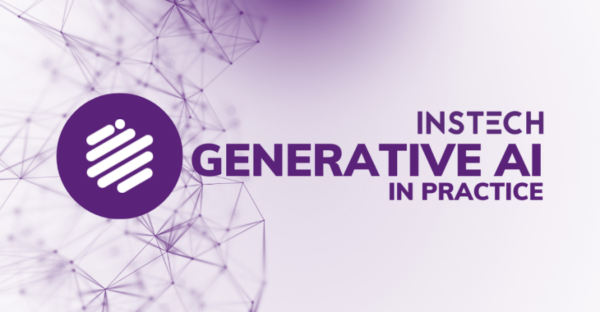Generative AI in Practice is InsTech’s monthly newsletter dedicated to the use of generative AI in insurance.
The InsTech Perspective
The AI shortage
The insurance industry has traditionally been a slower adopter of technology than its financial services peers. Initially, generative AI looked like it could break this trend. The launch of ChatGPT suddenly captured the attention of workers and executives alike; every company felt it needed to respond and most had no prior experience with GenAI.
While it is still early days for GenAI adoption, one factor does appear to be slowing insurers down: processing power. Supply of graphics processing units (GPUs), which advanced AI models rely on, has not caught up with the recent surge in demand. Microsoft, Google and other cloud computing firms cannot provide enough processing power for every company to use GenAI at scale in a private environment (insurers prefer privately hosted models for data privacy reasons). As a result, AI processing power is left to the highest bidders and even large insurers have to wait for their turn.
Use case of the month
Algorithmic underwriting
For personal lines insurance, insurers have made decisions about what risks to insure at what price using algorithms for some years. For more complex risks, humans have remained the decision-makers.
In 2021, Ki became the first fully algorithmic Lloyd’s syndicate, working with Google Cloud to design AI models to underwrite complex risks. Since then, more commercial and specialty insurers have experimented with algorithmic or augmented (which usually means a human in the loop to confirm or override the algorithm’s decision) underwriting, including Canopius’ MGA Vave, Apollo in its collaboration with Artificial and Hiscox’s announcement below.
To make algorithmic underwriting work in practice, insurers need to get their data in order. Historic data about their portfolio needs to be structured so that an algorithm can be trained to understand the features of good and bad risks. Email submissions from different brokers need to be converted into a format that is ready for the algorithm to interpret. Generative AI’s ability to extract data from all sorts of documents and text will play a key role in the growth of algorithmic underwriting in commercial and specialty insurance.
What the insurance industry is doing with GenAI
Hiscox is using generative AI technology from Google Cloud to launch an augmented underwriting capability for lead underwriting.
The Hartford is using generative AI to help its employees review policy documents, in partnership with Accenture.
SCOR is using large language models (LLMs) to search for information, detect context and summarise documents.
QBE has experimented with using GenAI to scan 4000-page submissions that usually take days for an underwriter to read. The AI completed the task in 50 seconds.
Liberty Mutual’s legal team is piloting GenAI to review complicated documents.
Australian insurer TAL has given 300 of its staff early access to Microsoft’s 365 Copilot virtual assistant, powered by GenAI.
Broker Miller has launched an in-house ChatGPT equivalent for its employees using technology from Microsoft and OpenAI.
Claims management firm Sedgwick is using OpenAI’s GenAI model GPT-4 to automate routine tasks and help employees deal with claims documentation.
Munich Re, which insures against losses from underperformance of AI models, is considering extending its Insure AI products to cover copyright infringement and bias risks.
News from the InsTech network
Robin Merttens and Matthew Grant give their perspective on automation and AI in their end-of-year reflection.
The proof is in the statistics. Instabase’s Bas De Goei joins the InsTech podcast to talk about the practical impact of GenAI in insurance and why democratising automation is important.
Cytora and hyperexponential are joining us for a webinar on 31 January to discuss the technologies that can help underwriters get their jobs done.
QBE Ventures’s Head of Emerging Technology joins Indico Data’s podcast to discuss AI, investments and the future of insurance.
All respondents to EY’s 2023 Financial Services GenAI Survey said they were either already using or plan to use GenAI in their organisation, but insurance was the sector most sceptical of GenAI’s impact.
How can generative AI deliver on customers’ expectations of the claims process? Simplifai is hosting a webinar on 30 January to discuss.
Munich Re writes about the potential to use LLMs for life and disability insurance.
Generative AI will continue to be the ‘unknown known’ risk in 2024, according to Beazley’s Group Head of Cyber Risks.
Other news and insights we’ve seen
Brokers at Aon, Marsh and WTW explain how AI-generated content is affecting the liability exposure of media companies.
The directors’ and officers’ liability risks associated with GenAI include unrealistic investor expectations, increased regulatory risk and demand for more corporate transparency, according to Allianz.
The National Association of Insurance Commissioners in the US has agreed a set of recommendations (not binding regulations) on how insurers should use AI. It expects all insurers to develop a written policy for responsible AI use to protect consumers.
Advisory company ISG found that the perceived return on investment from AI among insurance industry executives dropped from 54% in 2022 to 31% in 2023. This is likely to be due to increased experimentation and higher expectations driven by GenAI.
How InsTech has used AI this month
We took some time off over the new year, so we asked ChatGPT to fill in for us for a podcast episode on New Year’s Eve. We even used AI to generate a voice. The high number of downloads for the episode so far is worrying the humans who usually host the podcast. Listen to it here and let us know what you think.
Find out what you missed
Issue 5: In-house chatbots, AI in healthcare and designing reports
Issue 4: Catastrophic risks, insuring AI and pet insurance insights
Issue 3: Claims automation, billion-dollar spends and AI-generated business plans
Generative AI in Practice is InsTech’s monthly newsletter dedicated to the use of generative AI in insurance – you can sign up for free here.


